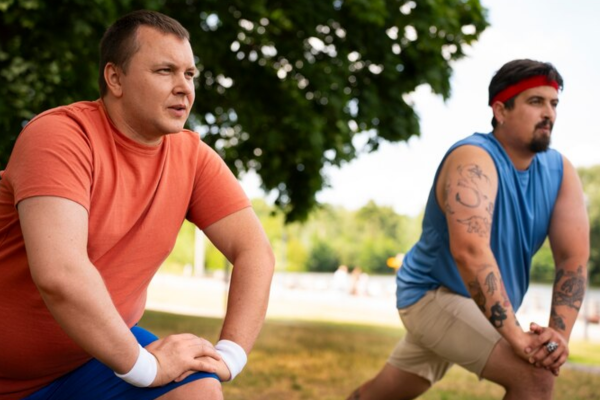In today’s fast-paced world, it’s common to experience aches and pains due to various reasons such as poor posture, stress, or overexertion. These discomforts can significantly hinder our daily activities and overall well-being. But fret not! With a few simple lifestyle adjustments and remedies, you can alleviate those nagging pains and get back to feeling your best in no time.
In this blog, we'll explore practical strategies to help you bid farewell to those increasing aches and pains within days.
The Significance Of Swift Pain Relief In Daily Life
Imagine waking up with a pounding headache that threatens to derail your entire day. In such moments, the ability to swiftly alleviate that discomfort not only restores your clarity of mind but also allows you to tackle your tasks with renewed energy and focus.
Swift pain relief empowers us to navigate through our daily responsibilities, whether it's meeting deadlines at work, caring for our families, or pursuing personal interests, without being hindered by persistent discomfort. Moreover, rapid pain relief isn't just about getting through the day—it's about reclaiming our sense of vitality and enjoyment in life.
Whether it's the freedom to engage in physical activities without inhibition or the ability to savour moments of relaxation without the distraction of nagging pains, swift relief enables us to fully embrace and appreciate the richness of our daily experiences. It fosters a greater sense of control over our bodies and emotions, allowing us to approach each day with resilience and optimism.
Identifying The Root Causes
The factors underlying our aches and pains is the first step towards effective relief. Often, these discomforts stem from a variety of sources, each deserving of our attention and understanding.
1. Poor Posture:
Poor posture has become increasingly prevalent in today's society, largely due to the widespread adoption of sedentary lifestyles and the omnipresence of digital devices. Many of us spend extended periods sitting at desks, slouched over computers, or hunched over smartphones, often without realising the strain we're putting on our bodies.
When we slouch or hunch forward, we compress our internal organs, potentially hindering their function and impeding proper digestion, circulation, and even breathing. Additionally, research has shown that posture can influence our mood and cognitive performance, with poor posture being associated with increased feelings of stress, fatigue, and decreased alertness.
2. Stress:
Stress, often dubbed the "silent killer," has profound effects on both our mental and physical well-being, and its role in exacerbating aches and pains should not be underestimated. When we experience stress, our bodies enter a state of heightened alertness, triggering a cascade of physiological responses, including increased muscle tension and elevated levels of stress hormones like cortisol.
Over time, this chronic state of tension can lead to muscle stiffness, headaches, and generalised body aches, making it a significant contributor to our daily discomfort. Furthermore, the mind-body connection means that mental stress can manifest physically, exacerbating existing pain conditions and creating new ones.
3. Overexertion:
Overexertion, often driven by our desire to push our limits or meet demanding physical demands, can lead to aches and pains that hinder our daily activities. Whether it's pushing through an intense workout, lifting heavy objects without proper form, or engaging in repetitive tasks for extended periods, overexertion places excessive strain on our muscles and joints, leading to fatigue, soreness, and even injury.
While moderate physical activity is essential for maintaining health and fitness, overexertion can have detrimental effects, particularly when combined with inadequate rest and recovery. Moreover, overexertion doesn't just affect physical performance; it can also impact our mental and emotional well-being.
Addressing Potential Triggers Effectively
Now that we've identified the potential triggers behind our aches and pains, it's time to embark on a journey towards effective relief. Armed with an understanding of how poor posture, stress, and overexertion contribute to our discomfort, we can implement targeted strategies to address these underlying causes.
1. Prioritise Proper Posture:
Prioritising proper posture is a cornerstone of effective pain management, as it lays the foundation for a strong and resilient body. By consciously aligning our spine and maintaining a neutral position while sitting, standing, and moving, we can alleviate strain on our muscles and joints, reducing the risk of discomfort and injury.
Simple adjustments, such as sitting up straight, supporting the lower back with a cushion, and taking regular breaks to stretch and reset, can make a significant difference in how we feel throughout the day. Moreover, proper posture isn't just about physical alignment—it also influences our mental and emotional well-being.
Sitting or standing with confidence and poise can boost self-esteem and foster a sense of empowerment, while slouching or hunching can convey feelings of insecurity and fatigue. By cultivating mindfulness and awareness of our posture, we can not only improve our physical health but also enhance our overall presence and vitality in every aspect of our lives.
2. Incorporate Movement and Exercise:
Incorporating movement and exercise into our daily routine is essential for maintaining a healthy and pain-free body. Physical activity not only strengthens muscles and joints but also improves circulation, flexibility, and overall well-being.
Engaging in low-impact exercises such as walking, swimming, or yoga can provide gentle yet effective relief for aches and pains, without putting undue stress on the body. Furthermore, regular stretching is paramount for preventing stiffness and promoting flexibility, especially after periods of prolonged sitting or physical exertion.
By incorporating dynamic stretches that target major muscle groups, we can release tension, improve range of motion, and reduce the likelihood of injury. Listening to our bodies and honouring their need for movement and rest is key to achieving sustainable pain relief and long-term health.
3. Practice Stress Management Techniques:
Practising stress management techniques is crucial for alleviating the physical and mental toll of stress on our bodies. Deep breathing exercises, meditation, and mindfulness practices are powerful tools for calming the nervous system, reducing muscle tension, and promoting relaxation.
By incorporating these techniques into our daily routine, we can counteract the detrimental effects of stress on our overall well-being. Additionally, prioritising self-care activities such as getting enough sleep, engaging in enjoyable hobbies, and nurturing social connections can help buffer against the negative impact of stress.
By carving out time for activities that bring us joy and fulfilment, we can cultivate resilience and strengthen our ability to cope with life's challenges. Ultimately, by managing stress effectively, we can not only alleviate existing aches and pains but also enhance our overall quality of life and vitality.
4. Ergonomic Workspace Setup:
Creating an ergonomic workspace setup is essential for promoting comfort and reducing the risk of aches and pains associated with prolonged desk work. This involves optimising the arrangement of furniture and equipment to support natural body alignment and minimise strain on muscles and joints.
Key considerations include adjusting the height and position of the desk, chair, and computer monitor to ensure that the spine remains in a neutral position, and the arms are comfortably supported while typing or using the mouse. Investing in ergonomic office furniture, such as an adjustable chair with lumbar support and a keyboard tray, can further enhance comfort and reduce the risk of musculoskeletal issues.
Additionally, incorporating accessories like a footrest or monitor riser can help maintain proper posture and alleviate strain on the neck and shoulders. By prioritising ergonomics in our workspace setup, we can create a conducive environment that supports our physical health and well-being, allowing us to work more comfortably and efficiently.
5. Regular Movement Breaks:
Regular movement breaks are essential for counteracting the negative effects of prolonged sitting and sedentary behaviour on our bodies. Incorporating short breaks to stand up, stretch, and move throughout the day helps to alleviate muscle tension, improve circulation, and reduce the risk of stiffness and discomfort.
These breaks also provide an opportunity to reset our posture, allowing us to maintain proper alignment and reduce strain on our muscles and joints. Moreover, regular movement breaks can have positive effects on our overall health and well-being, including increased energy levels, improved focus and productivity, and reduced stress.
By taking just a few minutes to move our bodies and engage in gentle stretches or mobility exercises, we can promote physical vitality and mental clarity, allowing us to approach our tasks with renewed vigour and enthusiasm. Incorporating these breaks into our daily routine is a simple yet powerful way to prioritise our health and well-being amidst the demands of modern life.
Conclusion
By prioritising proper posture, incorporating movement and exercise, and practising stress management techniques, you can effectively reduce and prevent aches and pains within days. Remember, consistency is key, so make these strategies a part of your daily routine for long-lasting relief and improved well-being.
FAQs
1. Can certain foods help alleviate aches and pains?
While there's no miracle food to cure all pains, consuming an anti-inflammatory diet rich in fruits, vegetables, whole grains, and healthy fats can help reduce inflammation and alleviate discomfort.
2. Is it advisable to use pain-relief medications for long-term relief?
While over-the-counter pain medications can provide temporary relief, relying on them for long-term management isn't ideal. It's important to address the root causes of your pain through lifestyle changes and seek professional guidance if needed.
3. How soon can I expect to feel relief from implementing these strategies?
The timeline for experiencing relief varies depending on individual factors such as the severity of your pain and how consistently you apply these strategies. However, many people report noticeable improvements within a few days to a week of incorporating these changes into their routine.














